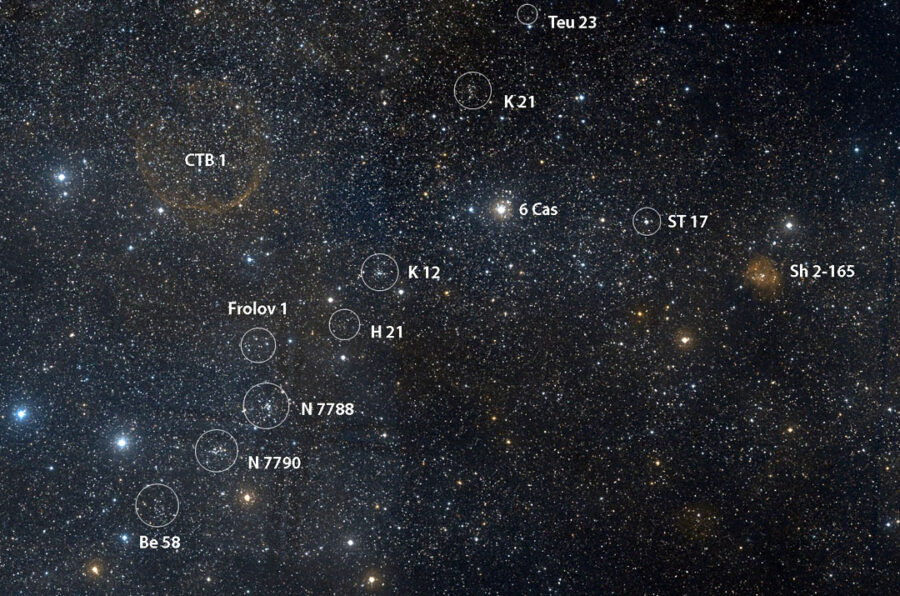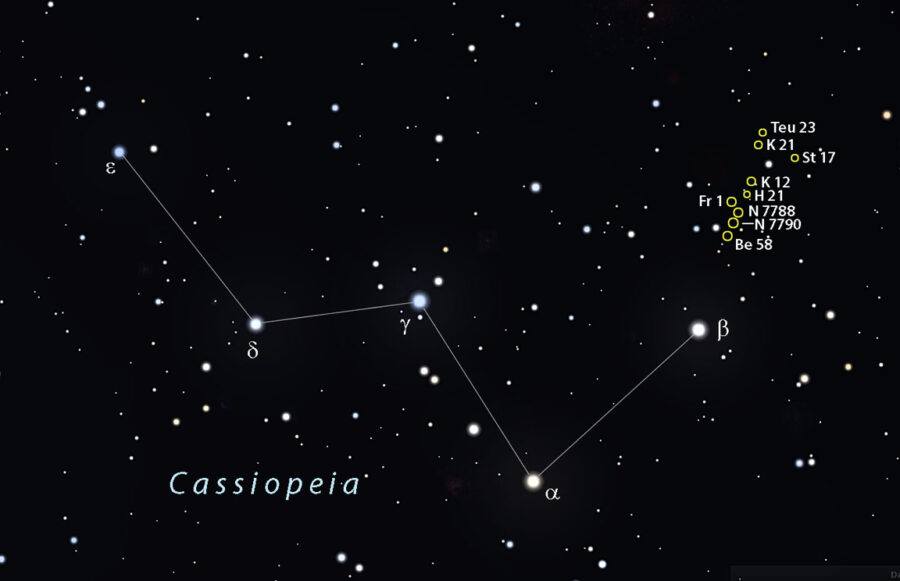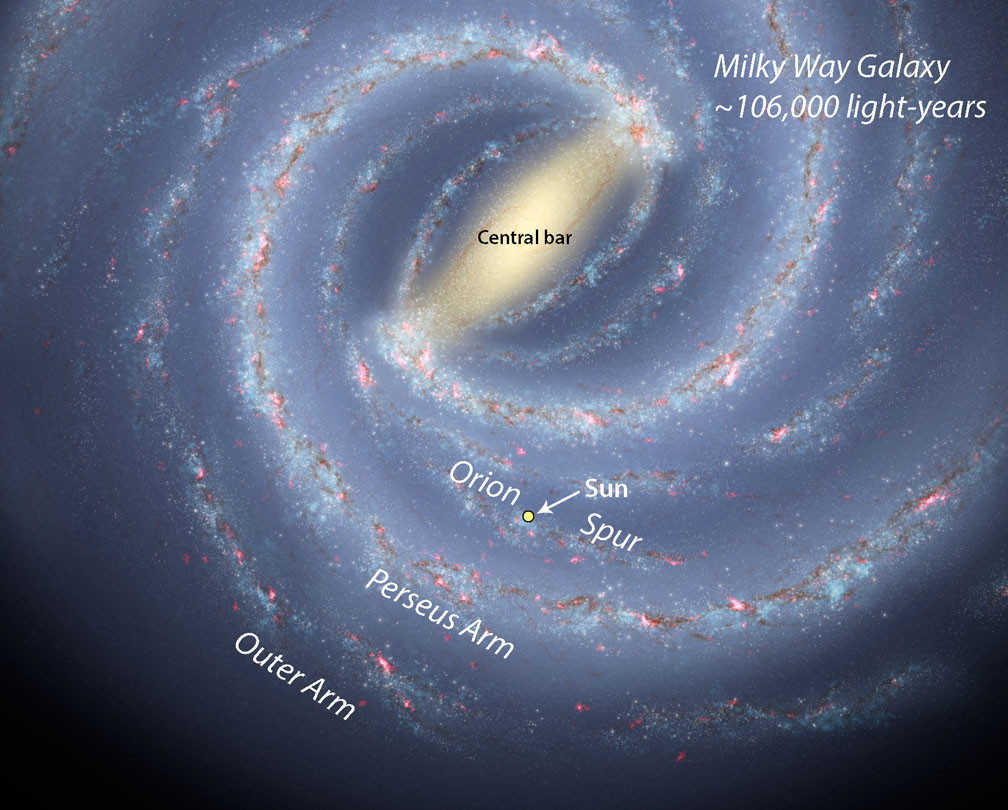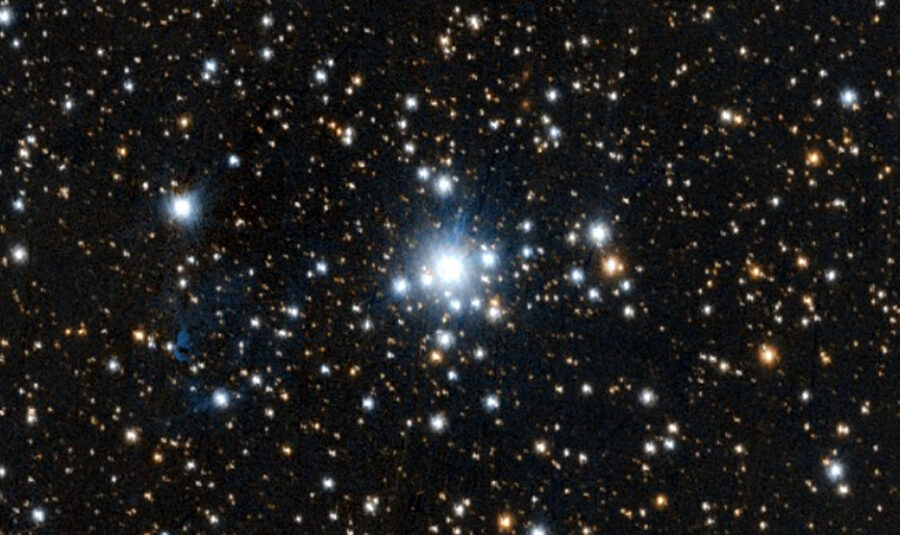See nine unique open clusters in Cassiopeia while barely moving your telescope.

DSS2 / Aladin Sky Atlas
I enjoy manually hunting for deep-sky objects no matter where they are in the sky, from star-starved Camelopardalis to easy-peasy Sagittarius with its fistfuls of guide stars. But given the choice, I'll happily take the path of least resistance. Wouldn't it be nice to just to point your telescope at a cluster or nebula and effortlessly slide to six or seven more with just the push of a finger? Well, you can.

Stellarium with additions by Bob King
Just 2° northwest of Beta (β) Cassiopeiae stretches a remarkable, compact row of eight small open clusters in the space of 2.5°. While not a geometrically perfect line it's close enough that a simple push takes you from one group to the next. I can easily fit four of these starry splashes in a single 1° field of view. Together they make for a delightful night of observing and a chance to experience the fecundity of the northern Milky Way before winter's cold bite.
I've also included a ninth cluster a short distance off the main trail because it was simply too interesting to pass up. Most of these objects will show well in an 8-inch telescope (and several in smaller instruments) under good skies. I used a 15-inch Dob for my observations. Starting at 2nd-magnitude Caph, I star-hopped to a pair of 6th-magnitude stars, beginning my run at Berkeley 58 and heading northwest. All were visible right off the bat using a magnification of 64×.
| Name | R.A. | Dec. | Mag. | Dia. | # stars |
| Berkeley 58 | 00h 00.2m | +60° 56.5′ | 9.7 | 5.0′ | 39 |
| NGC 7790 | 23h 58.4m | +61° 12.5′ | 8.5 | 5.0′ | 134 |
| NGC 7788 | 23h 56.7m | +61° 24.0′ | 9.4 | 4.0′ | 20 |
| Frolov 1 | 23h 57.5m | +61° 37.4′ | 9.2 | ~5.0′ | 26 |
| Harvard 21 | 23h 54.3m | +61° 43.7′ | 9.0 | 3.0′ | 6 |
| King 12 | 23h 53.0m | +61° 57.0′ | 9.0 | 3.0′ | 15 |
| King 21 | 23h 49.9m | +62° 42.0′ | 9.6 | 4.0′ | 20 |
| Teutsch 23 | 23h 47.9m | +62° 59.8′ | ~9.0 | 1.8′ | ~10 |
| Stock 17 | 23h 43.8m | +62° 09.6′ | ~9.5 | 1.0′ | ~15 |
Let's dive in!

William Maxwell
Berkeley 58 — A moderately rich cluster of mostly 13th-magnitude and fainter stars with an intriguing, misty appearance. It stands out well despite its weakly concentrated core. The group is elongated northeast-southwest with a shape that reminds me of a bouquet of flowers.
NGC 7790 — Beautiful! A small, rich cluster elongated east-west and sparkling with stars of 10th magnitude and fainter. It stands out boldly in the field of view, with its brightest member — tinged faintly red — at the cluster's western edge. A loose collection of more luminous stars dominates the cluster's western half. Fainter, more numerous stars in the eastern half give the object a lopsided appearance. Using averted vision and 142×, I detect short, curved strings of suns within this fainter portion that give it a splashy appearance.
NGC 7788 — A gem you must add to your cluster keepsakes. Despite having a smaller size and lower star count than its neighbor NGC 7790, it's endowed with a larger number of bright members, and they're tightly packed together in the form of a lizard's foot. A 9.2-magnitude star shines close to the cluster's center. Enjoy at low magnification first, then use moderate power to better appreciate the patterned core.
Beyond the NGC

NASA / JPL-Caltech / ESO / R. Hurt
Frolov 1 — A loosely bound group extended north-south. Its brightest members trace a looping figure that resembles a mirror image of the constellation Scorpius. Although star-poor and unconcentrated I can readily distinguish it from random background stars.
Harvard 21 — Sparse and unconcentrated. I see five 12th-magnitude stars arranged in two short arcs along with a smattering of fainter potential cluster members in the vicinity.
King 12 — Gorgeous, compact pile of suns! A tight, equal double star with a separation of ~3″ dominates the cluster's center. A second fainter, close double lies almost due north of this pair — nice surprises bundled inside a pretty parcel. King 12, along with NGC 7788 and NGC 7790, are all close to each other in the sky and have similar young ages. This suggests that they were all born around the same time within the same giant molecular cloud.

DSS2 / Aladin Sky Atlas
King 21 — Two brighter stars (magnitudes 10.8 and 11.7) stand out in the center of a haze of fainter members that resembles a cloud of tiny gnats. The mist easily resolves at 142× into a pretty, rich halo of similar-magnitude stars extended north-south. The 11.7-magnitude star is a close, unequal pair with a separation of ~4″. A lovely object all in all.
Teutsch 23 — This tiny, compact cluster boasts some 10 suns of magnitude 12 and fainter, two of which are neat doubles when viewed at 150× and higher. Neither bright nor rich, its teeny-weeniness makes it stand out just the same. An 8.4-magnitude star shines just 1.6′ south of the object. Teutsch 23 is a recent addition to the Milky Way's family, appearing on a list of likely new open clusters in the early 2000s.

PanSTARRS / DR1, Aladin Sky Atlas
Stock 17 — One of 24 open clusters compiled by Jürgen Stock in the early 1950s. I included this out-of-the-way clutch because of its unique appearance. You'll find it 35′ west of the 5.6-magnitude star 6 Cassiopeiae.
At first you'll see only its brightest member, an 8.5-magnitude star surrounded by a suspicious, grainy glow. But if you increase the magnification to around 200× and use averted vision, a dense sprinkle of fainter stars materializes, huddled close to the luminary. Several of the stars align to create a pair of "arms" extended in welcome.
 10
10








Comments
Andrew James
September 30, 2021 at 1:48 am
Love this article. NGC 7788 is just wonderful, but "A magnitude -9.2 star shines close to the cluster's center.", you'd need sunglasses!
You must be logged in to post a comment.
Bob KingPost Author
September 30, 2021 at 6:59 am
Hi Andrew,
Whoa, that would be sunglasses-worthy! Glad you enjoyed the article. I had fun making the observations and writing it. That's actually a hyphen (no space between the word and number) and not a negative sign, but I can see how it could be misinterpreted, so I removed it. Thanks for your comment!
You must be logged in to post a comment.
Andrew James
September 30, 2021 at 7:59 pm
You've made me think. I do sometimes mix up NGC 7788 with NGC 7789, being 5.5° due south of this collection (that my notes lyrical call the Cassiopeia Cascade) and is mirrored on the other side of Beta Cephei. I saw most of these in 1997 from Devon, England. After seeing all these, perhaps some of the readers here might like to check NGC 7789 too. Here's some of my notes...
NGC 7789 (23h 57.4m +56° 43′) is a delightful moderately sized rich galactic cluster in Cassiopeia and remains one of my favourite northern clusters. It is notably populated with many stars around or lower than roughly 11th magnitude.
This is a very impressive and grand deep-sky object in >20cm apertures, but smaller telescopes see it as an almost unresolved cloud. In moderate seeing with 15cm., many stars just seem to dance in and out of view. It also reminds me of a globular cluster mimic, where the fainter stars are just out of reach in resolution. [Like Musca globular NGC 4372.] Larger apertures NGC 7789 is breathtaking, where observers still comment on the seemingly general uniformity of stellar brightness.
This also is like those few clusters that seems slightly different using several eyepiece magnifications when using small to moderate telescopes – where increased power starts to readily resolves the haze into many faint stars. NGC 7789 has numerous, including eleven variables, eight being EB or EW type eclipsing binaries. This cluster is fairly old, much like M67 in Cancer.
You must be logged in to post a comment.
Bob KingPost Author
October 2, 2021 at 11:44 am
Lovely description, Andrew. Thank you for sharing it with our readers.
You must be logged in to post a comment.
Dave Mitsky
October 2, 2021 at 6:39 pm
I've observed a few of these open clusters, including King 12, but was unfamiliar with some of the others discussed in this article.
While doing some of my customary binocular observing prior to and after telescopic observing last night, I viewed NGC 7789, which was naturally only an unresolved hazy patch, M52, and M103 in Cassiopeia using Canon IS 15x50s. NGC 7789 is one of my favorite open clusters and I've observed it many times through quite a variety of binoculars and telescopes.
I plan on taking a look at the clusters in your article that I haven't seen before in the near future.
You must be logged in to post a comment.
Dave Mitsky
October 2, 2021 at 6:42 pm
Bob,
Would please delete the s in articles in the final sentence.
Thanks!
You must be logged in to post a comment.
Bob KingPost Author
October 4, 2021 at 12:47 am
Dave,
Sure! And thanks for writing. NGC 7789 is one of my very favorite clusters, too. I just get lost in all that richness.
You must be logged in to post a comment.
Andrew James
October 4, 2021 at 4:23 am
Good comment. I did too. Stuck in the southern hemisphere I'm now unable to see Cassiopeia at all, and although this part of the Milky Way is relatively thin, I still remember those sweeps. I saw Cassiopeia as a constellation 23 years ago. NGC 7789 is an elusive deep-sky object whose charm is that it looks different depending on aperture and magnification. I spent merely five nights exploring the northern cap, but the longest time was on this open cluster and a heap of close double stars.
Apologies from distracting from you chain of clusters.
You must be logged in to post a comment.
JUrban
October 7, 2021 at 3:44 pm
A great article, Bob! Looking forward to trying this out on the next clear night!
You must be logged in to post a comment.
Bob KingPost Author
October 8, 2021 at 10:39 am
Hey Josh,
Thanks! I enjoyed exploring these and hope you feel the same joy I did when you look them up.
You must be logged in to post a comment.
You must be logged in to post a comment.